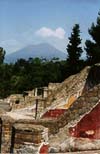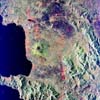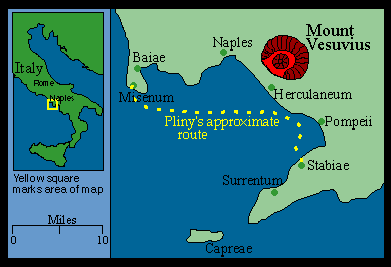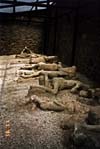Mount Vesuvius
Today two million people live in the immediate vicinity of
Mount Vesuvius. This mountain has erupted more than 50 times since the eruption in 79
A.D., when it buried Pompeii and its sister city, Herculaneum. After Pompeii was buried
and lost to history, the volcano continued to erupt every 100 years until about 1037 A.D.,
when it entered a 600-year period of quiescence. In 1631, the volcano killed an additional
4000 unsuspecting inhabitants. It was during the restoration after this eruption that
workers discovered the ruins of Pompeii, buried and forgotten for nearly 1600 years. It
would take another 300 years for the excavations to reveal the story of Pompeii and
Herculaneum. For excellent coverage of Pompeii, Vesuvius, and the continuing narrative of
tragic human involvement with nature, readers may want to locate a copy of Planet
Earth: Volcano by Time-Life Books.
 The picture to the left shows Mount Vesuvius as
seen from the recently excavated ruins of Pompeii. Vesuvius is about 5 miles away. Try to
imagine huge, billowing, gray-black clouds like those at Mount St. Helens rushing toward
you at a hundred miles an hour. That is probably what the ancient Romans (whose body casts
are shown below) saw just before they were entombed by hot ash. Photo: Courtesy of Dr. James Botti. The picture to the left shows Mount Vesuvius as
seen from the recently excavated ruins of Pompeii. Vesuvius is about 5 miles away. Try to
imagine huge, billowing, gray-black clouds like those at Mount St. Helens rushing toward
you at a hundred miles an hour. That is probably what the ancient Romans (whose body casts
are shown below) saw just before they were entombed by hot ash. Photo: Courtesy of Dr. James Botti.
 The picture to the right is a
satellite radar image of Mount Vesuvius and its surroundings. Vesuvius is the purplish
cone near the center of the image with a prominent summit crater and radiating greenish
lava flows. This is not a true color image. Vesuvius stands in the middle of a much larger
and older eroded cone called Mount Somma, about half of which is still visible around the
east side of Vesuvius. The rectangular docks of the port of Naples are visible against the
dark water to the upper left of Vesuvius. The purplish areas with radiating lines above
and below Vesuvius are other modern cities. The locations of Pompeii and Herculaneum may
be approximated using the map shown below. This cropped image was taken by the SAR-C/X
instrument aboard the Shuttle in 1994. The rest of this image and others taken by the SAR
may be viewed by clicking here. The picture to the right is a
satellite radar image of Mount Vesuvius and its surroundings. Vesuvius is the purplish
cone near the center of the image with a prominent summit crater and radiating greenish
lava flows. This is not a true color image. Vesuvius stands in the middle of a much larger
and older eroded cone called Mount Somma, about half of which is still visible around the
east side of Vesuvius. The rectangular docks of the port of Naples are visible against the
dark water to the upper left of Vesuvius. The purplish areas with radiating lines above
and below Vesuvius are other modern cities. The locations of Pompeii and Herculaneum may
be approximated using the map shown below. This cropped image was taken by the SAR-C/X
instrument aboard the Shuttle in 1994. The rest of this image and others taken by the SAR
may be viewed by clicking here.
Pliny the Younger The
following excerpts are from an account written by Pliny the Younger to the Roman historian
Tactitus shortly after the 79 A.D. Mount Vesuvius eruption. While it is common for us to
think of this date as ancient, students may learn a great deal about volcanoes from this
first-person account. In terms of the age of a volcano, Pliny the Younger's writings are
really very recent. He wrote to record the events surrounding the death of his uncle,
Pliny the Elder.

On August 24 of 79 A.D., the area around Mount Vesuvius shook with a
huge earthquake. The mountain's top split open and a monstrous cloud raced upward. The
inhabitants of Pompeii were showered with ash, stones, and pumice. A river of mud was
beginning to bury the city of Herculaneum. The uncle of Pliny the Younger, known as Pliny
the Elder, was a commander of a fleet of war ships at Misenum (see map). He decided to use
his ships to rescue people close to the volcano. The nephew describes the huge cloud
towering over the area (Radice, 1969):
. . . its general appearance can best be expressed as being like a pine
rather than any other tree, for it rose to a great height on a sort of trunk and then
split off into branches, I imagine because it was thrust upwards by the first blast and
then left unsupported as the pressure subsided, or else it was borne down by its own
weight so that it spread out and gradually dispersed. Sometimes it looked white, sometimes
blotched and dirty, according to the amount of soil and ashes it carried with it. (p. 427)
Pliny the Elder's ship approached the shore near Pompeii.
Ashes were already falling, hotter and thicker as the ships drew near,
followed by bits of pumice and blackened stones, charred and cracked by the flames . . .
Meanwhile on Mount Vesuvius broad sheets of fire and leaping flames blazed at several
points, their bright glare emphasized by the darkness of night. (pp. 429, 431)
But they could not land because the shore was blocked by volcanic
debris, so they sailed south and landed at Stabiae. Hoping to quiet the frightened people,
the uncle asked to be carried to the bath house. Afterward he lay down and ate. Next,
hoping to quiet the inhabitants, he went to bed. The volcano did not do likewise, however.
By this time the courtyard giving access to his room was full of ashes
mixed with pumice-stones, so that its level had risen, and if he had stayed in the room
any longer he would never had got out. . . . They debated whether to stay indoors or take
their chance in the open, for the buildings were now shaking with violent shocks, and
seemed to be swaying to and fro as if they were torn from their foundations. Outside on
the other hand, there was the danger of falling pumice-stones, even though these were
light and porous. . . . As a protection against falling objects they put pillows on their
heads tied down with cloths. (pp. 431, 433)
Finally, the uncle decided to leave. The level of ash and pumice-stone
had risen to the point that a hasty departure seemed the best option.
. . . the flames and smell of sulphur which gave warning of the
approaching fire drove the others to take flight and roused him to stand up . . . then
[he] suddenly collapsed, I imagine because the dense fumes choked his breathing by
blocking his windpipe which was constitutionally weak and narrow and often inflamed . . .
his body was found intact and uninjured, still fully clothed and looking more like sleep
than death. (p. 433)
Later, Pliny the Younger and his mother leave Misenam to escape from the
approaching volcanic conflagration. They travel across country to avoid being trampled by
the crowds of people on the road.
We also saw the sea sucked away and apparently forced back by the
earthquake: at any rate it receded from the shore so that quantities of sea creatures were
left stranded on dry sand. On the landward side a fearful black cloud was rent by forked
and quivering bursts of flame, and parted to reveal great tongues of fire, like flashes of
lightning magnified in size. . . . We had scarcely sat down to rest when darkness fell,
not the dark of a moonless or cloudy night, but as if the lamp had been put out in a
closed room. You could hear the shrieks of women, the wailing of infants, and the shouting
of men; some were calling their parents, others their children or their wives, trying to
recognize them by their voices. People bewailed their own fate or that of their relatives,
and there were some who prayed for death in their terror of dying. (pp. 443, 445)
 People in 79 A.D., like Harry Truman in 1980, may have thought they "knew the
mountain." Photo: Courtesy
of Dr. J.A. Botti. People in 79 A.D., like Harry Truman in 1980, may have thought they "knew the
mountain." Photo: Courtesy
of Dr. J.A. Botti.
 Excavaters found that much of what
Pompeii looked like in 79 A.D. had been preserved by the ash that had fallen. A bakery
oven contained loaves of bread nearly 2000 years old! Victims of Vesuvius were
immortalized when their decomposed bodies left cavities in the hardened ash. The cavities
were filled with plaster to recreate victims much as they looked at the time of their
death. Photo: Courtesy of
Dr. J.A. Botti. Excavaters found that much of what
Pompeii looked like in 79 A.D. had been preserved by the ash that had fallen. A bakery
oven contained loaves of bread nearly 2000 years old! Victims of Vesuvius were
immortalized when their decomposed bodies left cavities in the hardened ash. The cavities
were filled with plaster to recreate victims much as they looked at the time of their
death. Photo: Courtesy of
Dr. J.A. Botti.
For more information about Pompeii, you can visit the Pompeii Forum Project
or TravelProducts.com's thorough
resources page on Mount Vesuvius.
[ Risk Analysis ] [ Mount Vesuvius ]
[
References ] [
PBL Model ]
[ Home
] [ Teacher
Pages ] [
Modules &
Activities ] |

